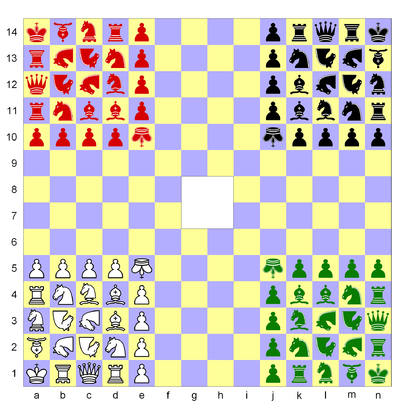
- Chess World Cup
- FIDE Grand Prix
- Olympiad
- World Championship
- List of strong tournaments
- List of world championships

- Checkmate patterns
- Chess openings
- Chess strategy
- Chess tactics
- Chess theory
- Endgames
- Pawn structure
- Problems/Compositions












 Quatrochess gameboard and starting position. In the diagram, standard pieces have their usual representations, as well as fairy pieces chancellor and archbishop. A mann is represented by an inverted king, wazir by inverted rook, fers by inverted bishop, giraffe by inverted knight, and camel by a horizontal knight.
Quatrochess gameboard and starting position. In the diagram, standard pieces have their usual representations, as well as fairy pieces chancellor and archbishop. A mann is represented by an inverted king, wazir by inverted rook, fers by inverted bishop, giraffe by inverted knight, and camel by a horizontal knight.Quatrochess is a chess variant for four players invented by George R. Dekle, Sr. in 1986. The board comprises 14x14 squares minus the four central squares. Each player controls a standard set of sixteen chess pieces, and additionally nine fairy pieces. The game can be played in partnership (two opposing teams of two) or all-versus-all.
Quatrochess was included in World Game Review No. 10 edited by Michael Keller.
The illustration shows the starting setup. White moves first and play proceeds clockwise around the board. Teammates sit in opposite corners in partnership games.
The squareless center may not be moved to or through; however, it may be jumped over by pieces that leap (knight, chancellor, archbishop, camel, and giraffe). The king, queen, rook, bishop, knight, and pawn move and capture as they do in chess. Each player's eight pawns are divided into two groups of four: one group moves forward along files, the other along ranks. As in chess, pawns have an initial two-step option, en passant is possible, and promotion occurs at the board's end. There is no castling in Quatrochess.
The fairy pieces all capture the same as they move:
When a player is checkmated or stalemated, his king is immediately removed from the game and his remaining men become the property of the player delivering the mate or stalemate (all-versus-all game), or of his teammate (partnership game). The last surviving player (or team) is the winner.